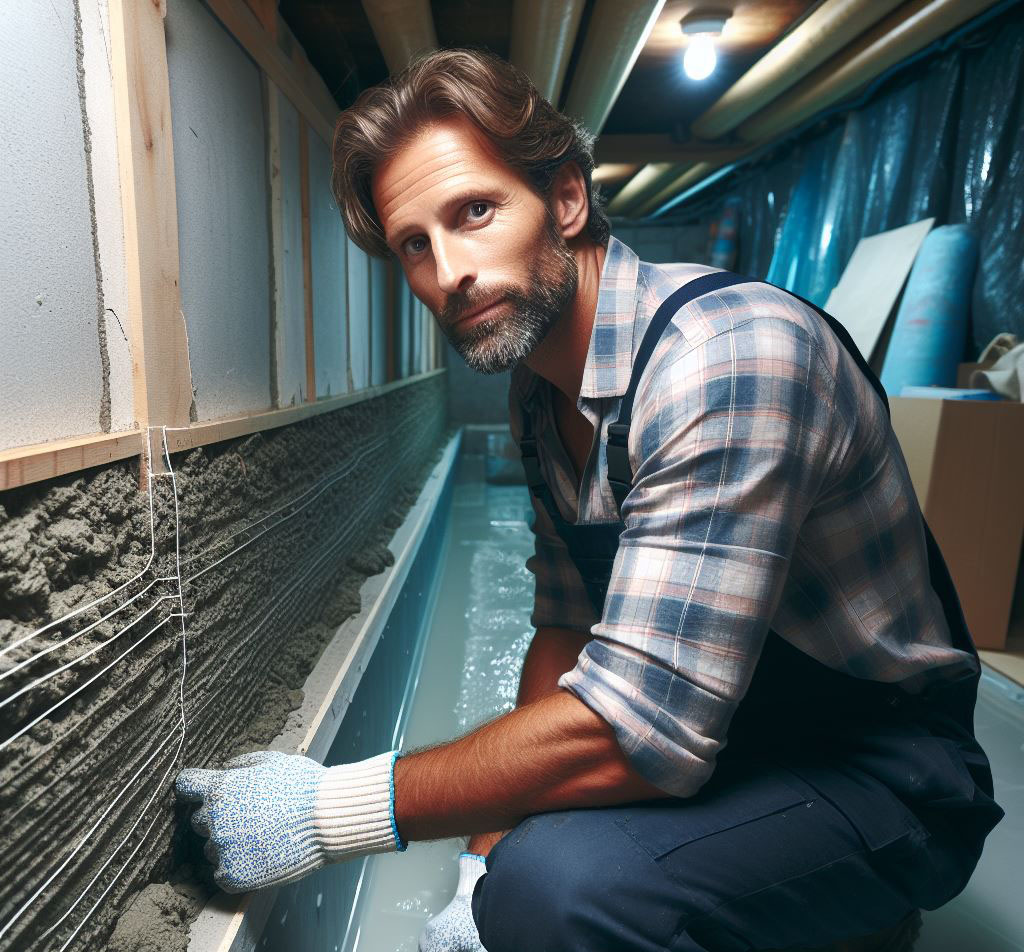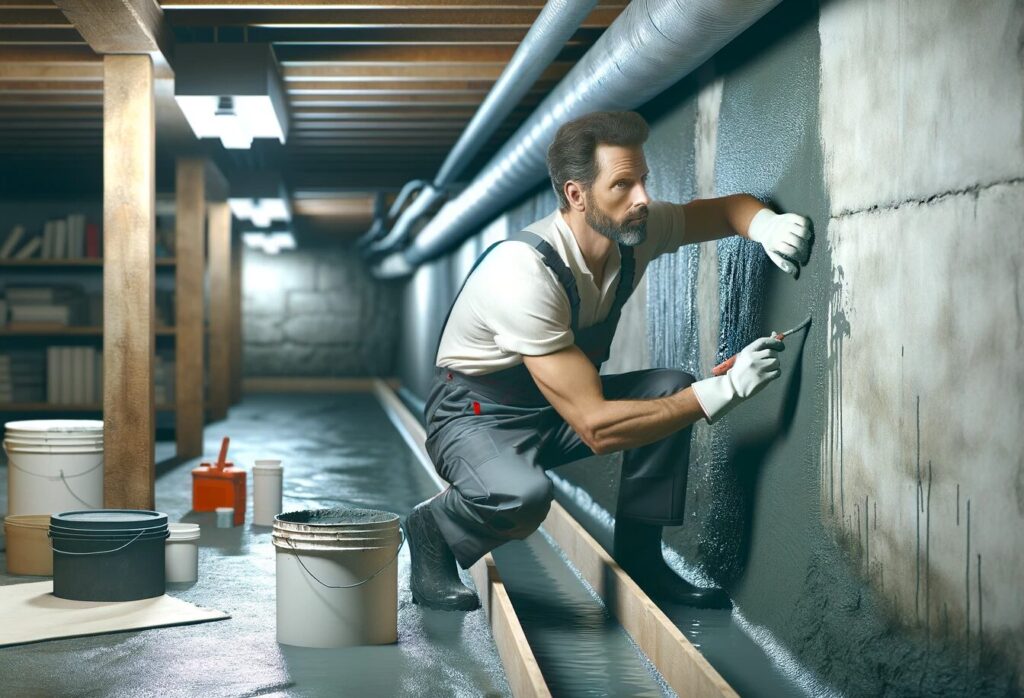Waterproofing basement walls is a crucial step in home maintenance, often overlooked until it’s too late. Throughout my years in construction, I’ve seen many homeowners face the consequences of water damage. This guide is tailored for the savvy home handyman and the small-scale construction professionals who are eager to protect their basements from the relentless assault of moisture.

Understanding the Need for Waterproofing
Why Waterproof? Imagine your basement as a fortress. Without proper defenses, water, the ever-persistent invader, will find its way in. The damage it brings isn’t just superficial, we’re talking about the kind of harm that goes bone-deep – mold proliferation and structural damage. It’s not just about the integrity of your building, it’s about the health of its inhabitants.
Spotting the Signs: Just like a seasoned doctor diagnoses a patient, learn to read your basement’s symptoms:
- Water trails or stains on walls or floors – these are the footprints of moisture.
- Paint that’s peeling off or efflorescence, signaling water’s silent invasion.
- The smell of dampness, a clear signal that mold has found a home.
- Walls or floors that are out of shape, indicating structural stress.
Preparing for Waterproofing
Safety First: Remember, your safety is paramount. Arm yourself with:
- Protective goggles and gloves – no compromises here.
- Ensure good ventilation, some waterproofing products can be noxious.
- A high-quality respirator, especially if you’re dealing with mold or mild chemicals.
Tools and Materials: Your toolkit should include:
- A sturdy brush for a thorough cleaning of the walls.
- Patching compound to fill and seal any cracks.
- Top-notch waterproofing paint or sealant. This is your main defense, choose wisely.
- Rollers or sprayers for even application.
- Chisel and hammer to tackle those stubborn areas.
- A dehumidifier to ensure the walls are bone-dry before you begin.
Prep Work:
- Clean House: A clean surface ensures better adhesion of waterproofing materials. Remove dirt, mold, and flaking paint with diligence.
- Inspect and Repair: Like a surgeon, meticulously identify and treat cracks and holes. Enlarge them slightly with your chisel, then fill them with patching compound. This isn’t just cosmetic, it’s crucial.
- Dry Run: The walls must be dry. Use a dehumidifier if necessary, moisture is your enemy in this process.
By understanding the critical role of waterproofing and meticulously preparing for the task, you’re not just maintaining your property, you’re enhancing its longevity and livability. Remember, every step taken towards waterproofing is a stride towards a safer, healthier home.
Choosing the Right Waterproofing Method
Selecting the appropriate waterproofing strategy is akin to picking the right tool for a job. It’s a decision that hinges on understanding your home’s specific needs and challenges. Let’s delve into the options:
- Interior vs. Exterior Methods: Think of interior methods as a bandage – they’re less invasive and can be applied with relative ease, ideal for minor issues. Exterior methods, however, are like surgery – more thorough and effective for significant water problems.
- Sealants: These are your primary shield against moisture. Inside, you’ll be working with waterproof paints and coatings that act as a moisture barrier. Outside, it’s more about applying robust membrane or cementitious coatings directly to the exterior walls.
- Drainage Systems: Sometimes, the best defense is a good route for water to escape. Interior drainage systems, like sump pumps, manage water by redirecting it. Exterior solutions, such as French drains, involve rerouting water away from your foundation.
Choosing What’s Right for You: Consider these key aspects:
- The extent of your water problem.
- The specific conditions of your basement.
- Your budget and tolerance for disruption.
- Local soil conditions and landscape.

Step-by-Step Guide to Waterproofing Basement Walls
- Interior Waterproofing
- Application of Sealants: Begin with a meticulous wall preparation, ensuring cleanliness and smoothness. Apply a waterproofing paint or sealant uniformly, using a roller for even coverage. This process creates a barrier, preventing moisture from seeping through.
- Installing Interior Drainage Systems: This involves creating a pathway for water to flow away from your home. Install a weeping tile system around the interior perimeter, leading to a sump pump that actively removes accumulated water.
- Exterior Waterproofing
- Excavation and Sealants: This method requires significant groundwork, excavating around your foundation to expose the exterior walls. After cleaning and repairing any damage, apply a waterproof membrane. This acts as a robust barrier against moisture.
- Drainage Solutions: Installing exterior drainage, like a French drain, involves digging a trench around your foundation, laying pipes, and filling it with gravel. This system effectively directs water away from your home, preventing accumulation.
In both interior and exterior waterproofing, each step is critical to the process. It demands precision, thoroughness, and a commitment to quality. The end result is a dry and secure basement, free from the worries of water intrusion and damage.

Maintenance and Upkeep
In the world of waterproofing, maintenance is your steady companion. It’s about keeping a vigilant eye and ensuring your work continues to stand the test of time and weather. Here’s how to stay ahead:
- Regular Inspections: Make it a habit to inspect your basement every spring and fall. Look for any telltale signs of moisture seepage or dampness, particularly after heavy rainfall or snow melts.
- Sealant Check-Up: Sealants aren’t immortal. Watch for signs of wear like cracking or peeling. This is your cue that they might need some TLC or a complete redo.
- Reapplication Timelines: A general guideline is to reapply sealants every 5 to 10 years, but this varies. The type of sealant used, the level of basement activity, and environmental factors play a role in this timeline.
Troubleshooting Common Issues
In my years on the job, I’ve encountered and solved a plethora of waterproofing issues. Here’s how you can do the same:
- Sealant Failure: Spotting water seepage? It’s probably time to reapply your sealant. Remember, the area must be clean and dry before you start your work.
- Drainage Problems: Water pooling where it shouldn’t be? Check your drainage systems. Ensure your gutters, downspouts, and sump pumps are clear of debris and functioning correctly.
FAQ Section
This depends on several factors, including the type of waterproofing used and the conditions of your basement. Generally, sealants need reapplication every 5 to 10 years. Systems like internal drainage can last longer, but regular maintenance checks are crucial.
If you have the know-how and the project is straightforward, a DIY approach can be effective. However, for extensive projects, especially those involving exterior work, professional help is recommended. The expertise and equipment they bring can be invaluable.
For older basements, consider less invasive methods like interior waterproofing with sealants and drainage systems. These techniques are typically less disruptive to the structural integrity of aged foundations.
Stay alert for signs like a musty smell, visible water stains, mold growth, or flaking paint and sealants. These indicators suggest that your waterproofing system may need attention.
Yes, regardless of the material. Each type, from concrete to stone, has unique needs but shares a common enemy in moisture. Tailor your waterproofing approach to the material, but never skip the step.
